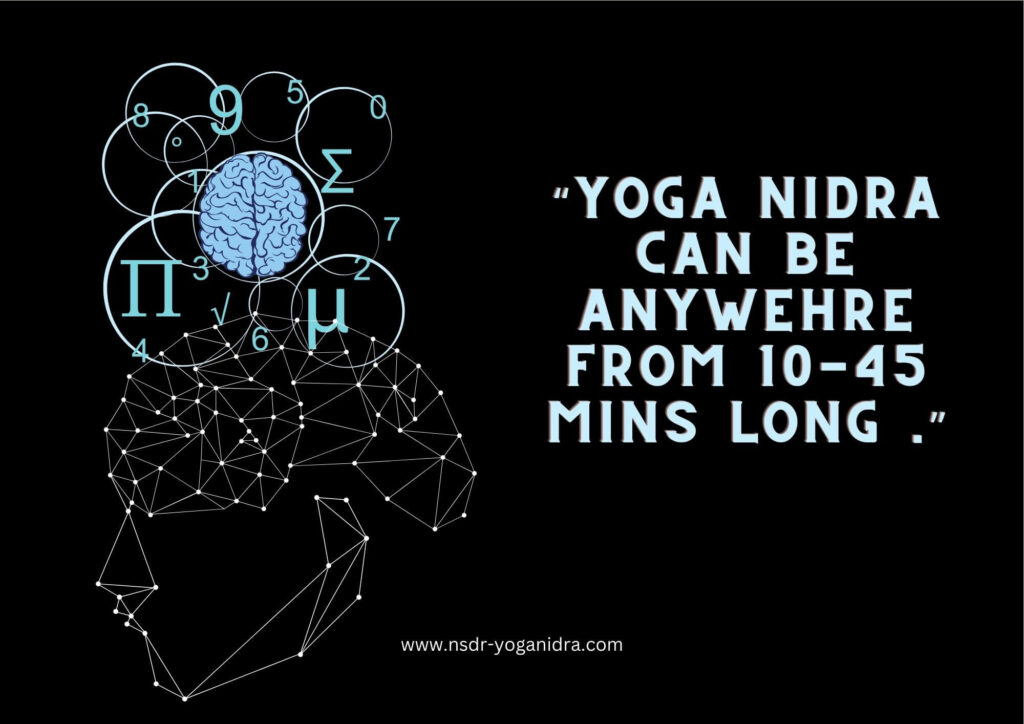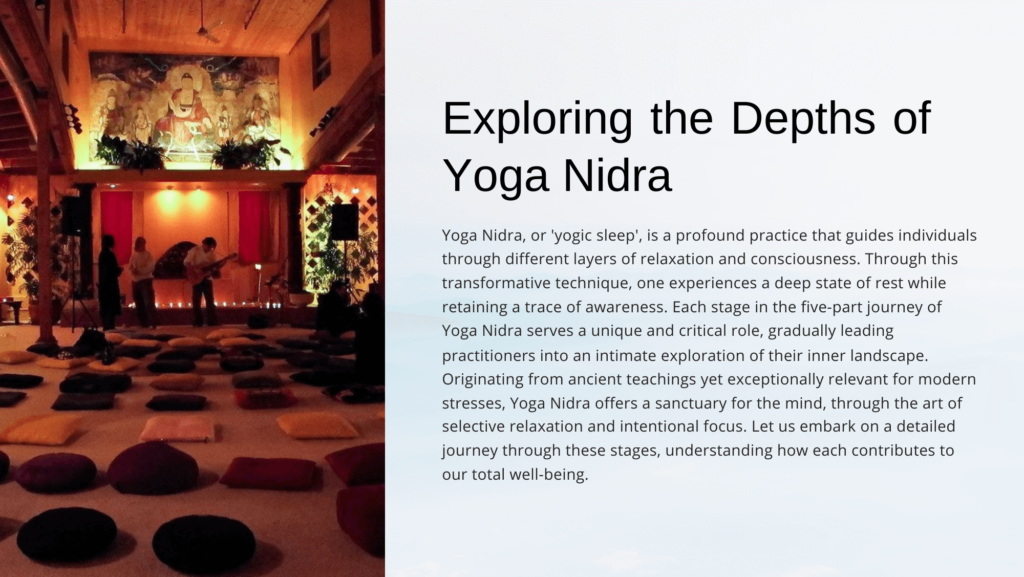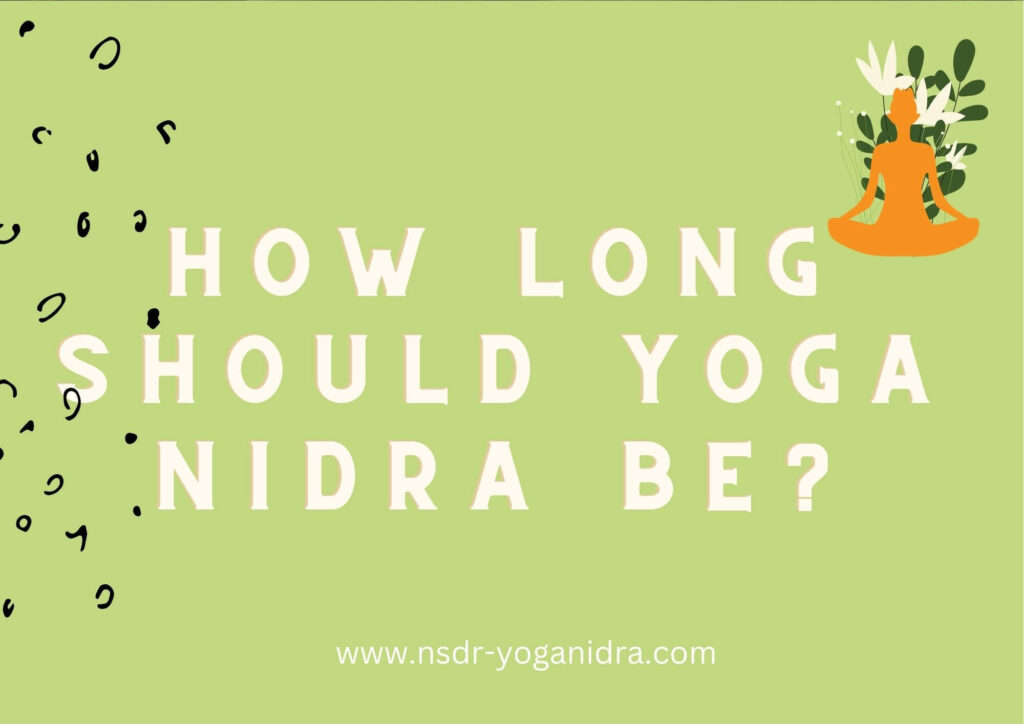Unlocking the mystery of the perfectly timed Yoga Nidra and the 5 stages and time during of each Yoga Nidra segment
How Long Should Yoga Nidra Be?
How long are Yoga nidras, you ask? Typically speaking a traditional Bihar School style Yoga Nidra can last anywhere between 10 to 45 minutes, allowing ample time for deep relaxation and guided practice. Many of the Amrit school of Yoga Nidras by Kamini Desai inspired Andrew Huberman to come up with the NSDR Protocol and are usually shorter- around 10-20 mins for the new age learner. The other schools that teach authentic forms of Yoga Nidra are Sri Sri School of Yoga and Isha Yoga amongst others. The ideal duration varies based on individual preferences, goals, and available time. It really isn’t difficult to begin a steady Yoga nidra practice once you make up your mind and it’s different from other other slow forms of mindfulness practices like yin yoga or hypnotherapy. Read more on the differences here.
In Yoga Nidra classes I often notice that newcomers get restless as they have not yet developed the ability to keep the mind steady or in Yogic terms- the ‘Vrittis’ in their minds are taking them away from the ‘stillness’ that is their nature. Shorter sessions of 10 to 20 minutes are suitable for beginners or those with limited time, while longer sessions of 45 minutes offer a more immersive experience, allowing for deeper relaxation and introspection.

When to Do Yoga Nidra?
Choosing the optimal time for your Yoga Nidra practice can significantly enhance its effectiveness. Consider incorporating Yoga Nidra into your daily routine during periods of heightened stress, before bedtime for improved sleep quality, or as a midday rejuvenation break. Experiment with different timings to find what works best for you and aligns with your lifestyle and schedule.
What are the Five Stages of Yoga Nidra?
The five stages of Yoga Nidra, each serving a distinct purpose and contributing to the overall relaxation and rejuvenation process.Each section has its own time duration as well. Here goes:
1. Preparation (5 minutes): This initial stage involves physical relaxation and mental preparation for the practice. It sets the tone for the session and helps transition the mind and body into a state of receptivity.
2. Setting Sankalpa (2 minutes): During this stage, practitioners set a positive intention or affirmation, known as Sankalpa, aligning their practice with personal goals and aspirations. This step cultivates a focused and purposeful mindset for the session.
3. Rotation of Consciousness (10 minutes): In this stage, attention is systematically directed to different parts of the body, promoting deep relaxation and awareness. By consciously releasing tension from each body part, practitioners enter a state of profound physical and mental relaxation.
4. Breath Awareness (5 minutes): Breath awareness techniques are employed to deepen relaxation and enhance mindfulness. Focusing on the natural rhythm of the breath calms the mind and anchors awareness in the present moment.
5. Visualization (5 -15 minutes- variable depending on time): The final stage involves guided imagery and visualization exercises, transporting practitioners to a state of deep inner awareness and tranquility. Visualization techniques stimulate the subconscious mind, fostering emotional healing, creativity, and self-discovery.
The five stages of Yoga Nidra are not only powerful elements to include in every yoga nidra practice but it’s also important to remember that even if your Yoga Nidra is for 10 mins, all or most of these stages should hold an important place in the audio.
Choosing the Right Timing for Your Yoga Nidra Practice
Now that you are aware of the five stages of Yoga Nidra, lets quickly dive into the following factors to determine how long Yoga Nidra should be and when to do Yoga Nidra as a practice.
– Personal Schedule: Choose a time when you can dedicate uninterrupted time and space to your practice. You should have quiet space around.
– Stress Levels: Practice Yoga Nidra during periods of heightened stress or fatigue to promote relaxation and rejuvenation.
– Sleep Quality: Incorporate Yoga Nidra into your bedtime routine to promote restful sleep and alleviate insomnia.
– Energy Levels: Use Yoga Nidra as a midday break to recharge and replenish your energy levels. Its perfect as a work- break.
-It is best to do Yoga Nidra on an empty stomach so that your energy does not get diverted to digestion.

By carefully selecting the timing of your Yoga Nidra practice and aligning it with your goals and lifestyle, you can maximize its benefits and experience deep relaxation, improved sleep, and enhanced overall well-being while boosting your brain power and adding to your longevity.


